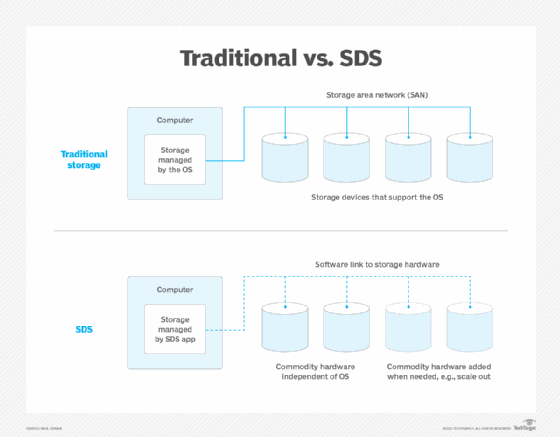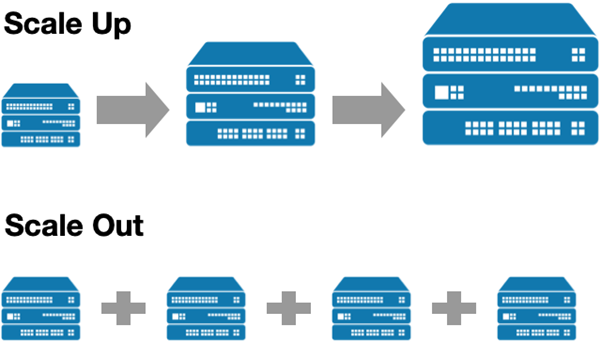Data is everywhere. Businesses distribute data across multiple locations, including on-premises and remote data centers as well as public clouds. Storing data safely and making it available is continuous effort that typically requires more space. Increasingly, software is coming to the rescue.
Software-defined storage (SDS) is the method of separating storage software from any physical piece of hardware, allowing organizations to efficiently manage large amounts of data with great agility regardless of network size. There are several key benefits to adopting SDS that empower businesses to effectively scale their operations or lower costs.
Key Takeaways:
- SDS enables flexibility in how companies can utilize their hardware.
- Low requirements and quick response times make SDS a convenient storage solution for IT personnel and consumers.
- Automation, optimization, and freedom from propriety all translate to savings for businesses utilizing SDS.
- Separation of hardware from software allows for near limitless scaling either upward or outward in an organization’s storage practices.
Understanding the benefits of SDS will make it clear how this technology is an investment organizations can hardly afford not to make.

How Software-Defined Storage Works
Abstraction is the core concept behind software-defined storage. It can be difficult to wrap one’s head around the idea of storing data without relying on physical hardware, but similar abstraction takes place during the common practice of virtualization, which is when a software program draws resources from one hardware location to create many virtual machines that are separate from the host server.
Another core tenet of SDS is compatibility. Whereas legacy storage options might entail the use of proprietary software that only works with specific hardware, SDS allows for the abstraction of storage resources from a wide variety of hardware.
The result is a network of data centers or clouds that facilitates the freedom of storing data anywhere, regardless of any compatibility issues that might otherwise exist.
Source: Tech Target
Visual comparison of traditional storage vs. software-defined storage
The components of a complete and functional software-defined storage strategy include:
- Hardware: Though SDS decouples data from its underlying hardware, the process requires physical storage devices from which to abstract resources.
- Abstraction technology: Abstraction occurs in SDS software, though different software solutions might utilize different abstraction methods.
- Software-defined networking: SDS makes it possible to store and even move data across multiple locations in a network, but the network itself may require a software-defined management approach in larger infrastructures.
- Automation: Automation can help ensure security and compliance and in the case of an SDS strategy, it serves to seamlessly allocate hardware resources across locations as necessary.
Software-defined storage is ultimately a pooled storage approach that enables administrators to add or remove hardware from a “pool” from which the software can draw resources for storage purposes. This is in contrast to the old standard of a hierarchical storage approach, which lacks flexibility and scalability.
Flexibility in Data Deployment
Companies are free from the constraints of how to use their hardware when utilizing SDS technology. It is possible to repurpose devices that were originally designed to use their internal resources in tandem with only very specific types of software. Administrators can configure and deploy a wide variety of hardware in nearly any way they see fit.
Business leaders can choose to use existing hardware to accommodate software-defined storage, or they can purchase new hardware. There is no lock-in, which also means that it is possible to diversify purchases among multiple hardware vendors.
A multi-vendor approach creates opportunities to lower hardware expenses and maintain a supply chain when problems arise. Adopting this multi-vendor approach for data storage purposes is only a valid solution when interoperability is on the table. SDS creates an environment in which interoperability is possible by unifying different storage solutions into a single resource pool even if they are not inherently compatible.
The sheer flexibility with which organizations can utilize hardware resources through SDS allows for adaptability to any circumstance. As storage demands change on the fly, a software-defined storage solution can reallocate resources to meet those demands, whether through manual interfacing or automation.
Convenience Leads to Simplified Success
It is difficult to overstate the importance of having a storage solution that is convenient for both internal teams and external consumers. SDS offers this convenience by empowering IT teams to complete tasks and satisfy requests with less resistance from the actual hardware or software.
One source of this convenience comes from the ability to quickly respond to changing circumstances in an SDS environment. When storage demands change anywhere in a network, meeting those demands is a simple matter of reallocating pooled hardware resources either manually or automatically.
Another source of convenience is the lack of requirements necessary for maintaining a software-defined storage solution. SDS is usable with nearly any server and can even run on a virtual machine. Virtual servers and virtual machines are, as it happens, important parts of a storage infrastructure utilizing SDS.
Cost Savings Provide More for Less
A convenient storage solution saves time and money. When teams can accomplish their tasks through simple and streamlined processes, it becomes possible to spend personnel and administrative resources elsewhere. The right SDS platform should, therefore, include a simplified control interface that allows administrators to manage storage without the need to navigate the underlying complexity.
Savings also come in the form of hardware purchases when software-defined storage frees businesses from proprietary control. An organization can acquire hardware according to its exact needs, rather than feeling stuck with a vendor that might only supply expensive hardware that provides far more storage than what is necessary.
SDS also allows for cost-effective programmability and automation. Effective automation translates to constant control and governance, lowering the risk of costly security breaches and downtime without the need to maintain a fully-staffed monitoring team.
SDS platforms are high-performance storage solutions. That level of performance stems from the specific optimization of storage based on software. The result is greater performance for less cost.
Scalability for Changing Circumstances
The nature of software-defined storage as a means of separating software from hardware also makes the efficient scalability of storage much more attainable. When hardware is independent of software, it is possible for a business to easily upgrade or downgrade its hardware loadout without the need to worry about how the change will affect the software.
A simplified focus on hardware scaling enables independent tuning of either the system’s storage capacity or its operational performance. Where the scaling of a legacy storage system might entail investing in capacity and performance as a package deal, scaling an SDS system makes it possible to target one or the other. This dynamic allows for faster, more on-demand scaling.
The scalability of software-defined storage is also practically limitless. Businesses using SDS have no restrictions based on the amount of physical space available or the number of nodes in a network. Instead, it is possible for SDS to quickly scale up or scale out by drawing resources from remote data centers or cloud providers.
Source: LinkedIn
Example of scaling up and scaling out, both of which are possible through software-defined storage
Deciding how best to scale in response to new storage demands is a matter of determining what the business needs. Adding new storage arrays increases the capacity available in the resource pool. Installing additional CPUs or memory can improve the system’s performance. When there is a need to improve both capacity and performance simultaneously, the solution might be to add more storage or include an additional node in the network.
Pros That Outweigh The Cons
Software-defined storage is not necessarily an end-all-be-all solution to every IT storage problem. There are circumstances under which the adoption of SDS might not be the best path forward. Knowing the potential pitfalls of using SDS can, however, empower businesses to implement this technology more appropriately.
A deceptive dependence on hardware is one potential drawback of using SDS, despite the key feature of the technology being the separation of software from hardware. The presence of hardware remains necessary for providing resources on which SDS can run. Another consideration is that even though interoperability is a mostly ubiquitous trait of SDS, some instances may arise when compatibility issues between hardware might emerge.
Complexity is another problem that can grow over time until it becomes uncontrollable. An ideal SDS system should come with an easy-to-use interface that hides the underlying complexity, but it is not a perfect solution. Scaling any IT system up only adds to the complexity, and the easy scalability of SDS makes increasing complexity into a slippery slope.
The technology behind software-defined storage is growing and improving at an impressive rate, however. An investment in this type of storage solution can bring great flexibility, long-term savings, and other benefits that may outweigh the cons for businesses that weigh the decision carefully.
Future-Proofing with the Right Software-Defined Storage Solution
There are several types of SDS solutions available, though choosing the right one depends on a company’s specific needs. These types include:
- Scale-out object
- Scale-out block
- Scale-out file
- Container-based
- Hyperconverged infrastructure
Regardless of which type of SDS a business adopts, the quality of that service depends on the provider’s ability to support the transformation process and to prioritize simplicity for the consumer organization’s IT operations.
Nutanix Unified Storage is a software-defined storage product that provides the benefits of multiple types of SDS technologies while also facilitating a smooth transformation from legacy storage. Consumers receive the networking, storage access, and connectivity services necessary to continue operations unhindered.
Organizations can future-proof their IT storage methods through SDS platforms such as Unified Storage. For example, the software-based approach can facilitate a streamlined setup of remote offices or make the implementation of hybrid cloud environments much more attainable. Perhaps the most broadly relevant use of SDS is in modernizing data storage systems that become increasingly out-of-date and overburdened in a time of rampant data proliferation.
One report indicates that, according to projections by Omdia, the software-defined storage market may reach $86 billion by the end of 2023. This apparent growth of SDS technology illustrates the necessity of adopting new storage solutions to overcome the limitations of legacy systems.
Learn more about other SDS solutions such as Nutanix Files and the success of these solutions on the market.
Michael Brenner is a keynote speaker, author and CEO of Marketing Insider Group. Michael has written hundreds of articles on sites such as Forbes, Entrepreneur Magazine, and The Guardian and he speaks at dozens of leadership conferences each year covering topics such as marketing, leadership, technology and business strategy. Follow him @BrennerMichael
© 2023 Nutanix, Inc. All rights reserved. For additional legal information, please go here.







